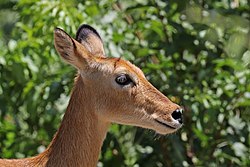| Puku | |
|---|---|
 | |
| Male (Zambia) | |
| Scientific classification | |
| Kingdom: | Animalia |
| Phylum: | Chordata |
| Class: | Mammalia |
| Order: | Artiodactyla |
| Family: | Bovidae |
| Genus: | Kobus |
| Species: | K. vardonii |
| Binomial name | |
| Kobus vardonii (Livingstone, 1857) | |
 | |
The puku (Kobus vardonii) is a medium-sized antelope found in wet grasslands in southern Democratic Republic of Congo, Namibia, Tanzania, Zambia and more concentrated in the Okavango Delta in Botswana. [1] Nearly one-third of all puku are found in protected areas, zoos, and national parks due to their diminishing habitat. [2] [3]






